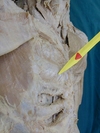Chest and lungs Flashcards
How many pairs of ribs are they? what do these articulate with posteriorly?
there are 12 pairs of ribs. these articulate posteriorly with the verterbral column.
what do the uppermost ten pairs of ribs articulate with?
articulate posteriorly with the verterbral column and anteriorly with the sternum
what are true ribs? which ribs are true ribs?
true ribs are directly attached to the sternum.
these are ribs 1-7
what are false ribs? which ribs are false ribs?
these ribs do not directly attach to the sternum.
these are ribs 8- 12
which ribs are floating ribs?
ribs 11 and 12
where is the sternal angle?
is with the first 4 vetebrae.
What are the three parts of the sternum?
the Manubrium
the Body
the xiphoid process
what is the sternoclavicular joint?
it’s between the sternum and clavicle
what is the clavicle?
the collarbone
what is the scapula?
the shoulder blade
what is the pectoral girdle?
the scapula and the clavicle
what is the suprsternal notch?
also known as the jugular notch, it is the large visible dip between the nech and the collarbone
what is the clavicular notch?
it is a notch on either side of the upper manubrium, this is the site of articulation between the manubrium and clavicle
what parts of the rib are there?
The head
The neck
the tuberoscity
how can you identify the external intercostal muscles?
they face downwards and forwards
how can you identify the internal intercostal muscles?
they face upwards and backwards at 90 degrees.
what vein, artery and nerve supply the intercostals?
the intercostal vein , the intercostal artery and the intercostal nerve.
what does the phrenic nerve supply?
supplies the diaphragm
what does the vagus nerve supply?
the thoracic viscera.
describe the right lung
3 lobes, two fissures, larger than the left lung.
describe the left lung
2 lobes, one fissure, smaller than the right lung. cardiac notch can be seen












